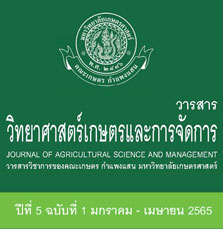CEffect of Artificial Lighting Source from LEDs and Temperature Control on Yield and Leaf Oil of Holy Basil and Sweet Basil
Keywords:
light emitting diode, holy basil, sweet basil, essential oilAbstract
The application of light emitting diode (LEDs) on yield and leaf oil of holy basil and sweet basil was investigated in Completely Randomized Design (CRD) with 4 replications and 6 treatments, at 25oC. The result showed that holy basil and sweet basil in controlled greenhouse with sun light yielded the highest leaf fresh weight and yield. The yield of holy basil in the condition of white, red, blue and red:blue (ratio 1:1) light LEDs was 3,564.44 3,488.89 3,333.33 and 3,306.67 grams per rai, respectively. These were significantly different from the holy basil grown outside the greenhouse that had the least yield of 2,608.89 grams per rai. Red light LEDs significantly increased the number of leaves and the increased number of leaves of sweet basil. All of LEDs treatment significantly increased leaf oil of holy basil and sweet basil. Holy basil contained 8.94 - 11.37 % of leaf oil and sweet basil contained 7.92 - 8.75 % of leaf oil which were significantly higher and significantly higher different than those of the outside grown with natural light
References
จิราภรณ์ โสดาจันทร์, บรรลือ สังข์ทอง และสกุลรัตน์ รัตนาเกียรติ์. 2558. องค์ประกอบหลักทางเคมีและฤทธิ์ในการยับยั้งเชื้อจุลชีพก่อโรคในช่องปากของน้ำมันหอมระเหยจากพืชสกุล Ocimum spp. วารสารเภสัชศาสตร์อีสาน 11 (ฉบับพิเศษ): 304-310.
ธนียา หาวิเศษ, ภควดี สมหวัง และณภัทร ศรีรักษา . 2558. ผลของการดมน้ำมันหอมระเหยกลิ่นส้มและกลิ่นกะเพรา ต่อความจำและอารมณ์ในอาสาสมัครเพศหญิง. เชียงราย : มหาวิทยาลัยแม่ฟ้าหลวง. (ระบบออนไลน์). แหล่งข้อมูล: http://www.tnrr.in.th ( 29 เมษายน พ.ศ. 2562).
ธรรมศักดิ์ ทองเกตุ. 2558. โรงงานผลิตพืช (ผัก) Plant factory. วารสารเกษตรอภิรมย์ 1 (6): 32-33.
นภัทร วัจนเทพินทร์ และไชยยันต์ บุญมี. 2560. ไดโอดเปล่งแสงสีอะไรเหมาะสมกับการปลูกพืช?. วารสารวิทยาศาสตร์และเทคโนโลยี 25 (1): 158-176.
ภานุกิจ กันหาจันทร์, พายุ ภักดีนวน, ชญาดา ขำสวัสดิ์, พัชราวรรณ สิริโสภา, ยุทธนา ภู่ทรัพย์, จักรวาล ชมพูศรี และศรีสุดา หาญภาคภูมิ. 2559. การศึกษาฤทธิ์ในการกำจัดลูกน้ำยุงของน้ำมันหอมระเหย 12 ชนิด. สถาบันวิจัยวิทยาศาสตร์สาธารณสุข กรมวิทยาศาสตร์การแพทย์ กระทรวงสาธารณสุข. (ระบบออนไลน์). แหล่งข้อมูล:http://nih.dmsc.moph.go.th ( 29 เมษายน พ.ศ. 2562).
สุกัญญา เขียวสะอาด. 2555. กะเพรากับการต้านอนุมูลอิสระ. วิทยาศาสตร์ลาดกระบัง 21 (2): 54-65.
Aldarkazali, M., H.Z. Rihan, D. Carne and M.P. Fuller. 2019. The growth and development of sweet basil (Ocimum basilicum) and bush basil (Ocimum minimum) grown under three light regimes in a controlled environment. Agronomy 9 (11): 743. doi.org/10.3390/agronomy
Yeh, N. and J.P. Chung. 2009. High-brightness LEDs-energy efficient lighting sources and their potential in indoor plant cultivation. Renewable and Sustainable Energy Reviews 13: 2175–2180.






